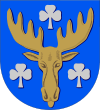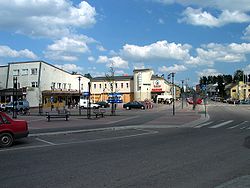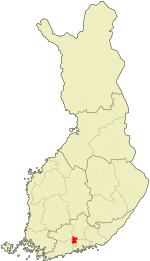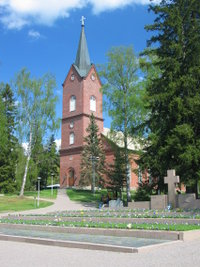- Mäntsälä
-
Mäntsälä — Municipality — Mäntsälän kunta Center of Mäntsälä: Main road 
Coat of armsLocation of Mäntsälä in Finland Country Finland Region Uusimaa Sub-region Helsinki sub-region Charter 1585 Government – Municipal manager Esko Kairesalo Area(2011-01-01)[1] – Total 596.10 km2 (230.2 sq mi) – Land 580.84 km2 (224.3 sq mi) – Water 15.26 km2 (5.9 sq mi) Area rank 198th largest in Finland Population (2011-01-31)[2] – Total 19,959 – Rank 56th largest in Finland – Density 34.36/km2 (89/sq mi) Population by native language[3] – Finnish 97.8% (official) – Swedish 0.8% – Others 1.3% Population by age[4] – 0 to 14 22.4% – 15 to 64 64.5% – 65 or older 13.1% Time zone EET (UTC+2) – Summer (DST) EEST (UTC+3) Municipal tax rate[5] 19.75% Website www.mantsala.fi Mäntsälä (Finnish pronunciation: [ˈmæntsælæ]) is a municipality in the province of Southern Finland, and is part of the Uusimaa region. It has a population of 19,959 (31 January 2011)[2] and covers an area of 596.10 square kilometres (230.16 sq mi) of which 15.26 km2 (5.89 sq mi) is water.[1] The population density is 34.36 inhabitants per square kilometre (89.0 /sq mi).
Mäntsälä lies about 60 kilometres (40 mi) north of Helsinki, the capital of Finland. During the last few years, the population of Mäntsälä has been one of the most rapidly increasing in Finland. A new railroad was built between Kerava and Lahti with passenger traffic starting on September 4, 2006 from Mäntsälä railway station. Helsinki is about 40 minutes away, and Lahti even closer.
The municipality is unilingually Finnish.
Contents
History
Mäntsälä is considered to have been founded in 1585, when the community's first church was built. The current church was completed in 1866 after delay. The Crimean War affected also Mäntsälä: funds for building the church were spent on war efforts. All of the churches were located on Kirkonmäki at about the same spot.
The first common school was founded in 1870 by way of a testament of clergyman Abraham Ehnroos. To his credit is the founding of a public library already in 1840. An intermediate school was not founded until 1945 with a high school following in 1954, previously facilities in Porvoo, Järvenpää and Helsinki were used.
In 1854 the first town hall was built on Kirkonmäki. Today a museum is operating in the building, having also served as a morgue, school kitchen and lesson space, and a dormitory. It is deteriorating severely and the museum is only opened upon request.
The second town hall was built in 1935, also on Kirkonmäki. It served until the completion of the present town hall in 1992. Now it houses an open college.
There is a total of 15 manors in Mäntsälä, 4 of which are open to the public, the rest being private residences. Russian czar Alexander I visited as guest of Ulla Möllersvärd in 1809 in the Mäntsälä manor lying in the city center. The manors emerged in the 17th century as noblemen feoffs. Traditionally the land belonged to the manors. There were many crofts in Mäntsälä and new legislation in 1918 enabled the crofters to claim the land for themselves. In the 1920s the manors were still a sizable land owner in the parish.
Mäntsälä is especially known for the Mäntsälä rebellion. About 400 civil guards went shooting to a Social Democratic party rally at Ohkola community hall, interrupting it. In the course of a few days leaders of Lapua Movement and armed civil guards from all over the country arrived to Mäntsälä. The government ordered them arrested, and after a speech by president Svinhufvud on March 2 the situation gradually settled down. The movement disbanded early in spring.
World War II brought about 2000 Karelian immigrants to Mäntsälä. They came mainly from Kirvu and Koivisto. Land was cut from the manors again for immigrants, reducing manor estate considerably. In 1985 a museum about the Kirvu parish was opened next to the church in the city center.
In 1992 an apartment trade fair was held in Mäntsälä. The area is being expanded and since 2006, a train depot lies next to it.
Population progress
The population of Mäntsälä has stayed quite level for decades, but the building of a motorway up to Järvenpää in the 1970s and the extension to Lahti in 1999 have brought new residents from the metropolitan area. By the middle of the 2000s the new railroad to Lahti has been central in municipality population growth. Many people moved to Mäntsälä because of the railroad, that offered quick commuting to Helsinki.
- 1749: 1,492 (unconfirmed)
- 1898: 7,972 (unconfirmed)
- 1920: 7,666
- 1930: 7,844
- 1940: 7,739
- 1950: 11,072
- 1960: 10,932
- 1970: 10,166
- 1980: 11,267
- 1990: 14,793
- 2000: 16,628
- 2005: 18,226
- 2007: 18,980
Famous Mäntsälä dwellers
Adolf Erik Nordenskiöld is considered to be originally from Mäntsälä, having spent his early youth on the family estate there, although he was born in Helsinki and lived also in Sweden. Nordenskiöld was a nineteenth century geologist and Arctic explorer.
Others include member of Lordi-band Jussi Sydänmaa alias "Amen", and former defence minister Elisabeth Rehn in her youth.
See also
References
- ^ a b "Area by municipality as of 1 January 2011" (in Finnish and Swedish) (PDF). Land Survey of Finland. http://www.maanmittauslaitos.fi/sites/default/files/pinta-alat_2011_kunnannimenmukaan.xls. Retrieved 9 March 2011.
- ^ a b "Population by municipality as of 31 January 2011" (in Finnish and Swedish). Population Information System. Population Register Center of Finland. http://vrk.fi/default.aspx?docid=4258&site=3&id=0. Retrieved 18 February 2011.
- ^ "Population according to language and the number of foreigners and land area km2 by area as of 31 December 2008". Statistics Finland's PX-Web databases. Statistics Finland. http://pxweb2.stat.fi/Dialog/varval.asp?ma=060_vaerak_tau_107_fi&ti=V%E4est%F6+kielen+mukaan+sek%E4+ulkomaan+kansalaisten+m%E4%E4r%E4+ja+maa%2Dpinta%2Dala+alueittain++1980+%2D+2008&path=../Database/StatFin/vrm/vaerak/&lang=3&multilang=fi. Retrieved 29 March 2009.
- ^ "Population according to age and gender by area as of 31 December 2008". Statistics Finland's PX-Web databases. Statistics Finland. http://pxweb2.stat.fi/Dialog/varval.asp?ma=050_vaerak_tau_104_fi&ti=V%E4est%F6+i%E4n+%281%2Dv%2E%29+ja+sukupuolen+mukaan+alueittain+1980+%2D+2008&path=../Database/StatFin/vrm/vaerak/&lang=3&multilang=fi. Retrieved 28 April 2009.
- ^ "List of municipal and parish tax rates in 2011". Tax Administration of Finland. 29 November 2010. http://www.vero.fi/nc/doc/download.asp?id=7996;193801. Retrieved 13 March 2011.
External links
- Municipality of Mäntsälä – Official website
- The oldest document in the statistical archives of Statistics Finland about the population of Mäntsälä in 1749
Municipalities of Uusimaa Municipalities Askola · Espoo · Hanko · Helsinki · Hyvinkää · Ingå · Järvenpää · Karjalohja · Karkkila · Kauniainen · Kerava · Kirkkonummi · Lapinjärvi · Lohja · Loviisa · Mäntsälä · Myrskylä · Nummi-Pusula · Nurmijärvi · Pornainen · Porvoo · Pukkila · Raseborg · Sipoo · Siuntio · Tuusula · Vantaa · Vihti
Former municipalities Categories:- Mäntsälä
- Municipalities of Uusimaa Region
Wikimedia Foundation. 2010.



